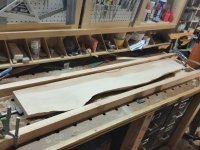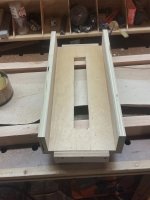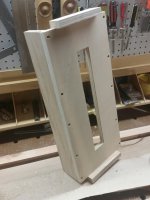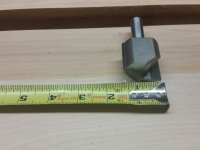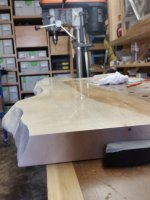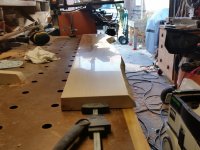ear3
Member
I still had half the maple slab I used on a radiator table, so i decided to work the other half into a similar piece. I was able to get away with just sanding the first half, because I chose the section with the least warping, but on this one I had no choice but to plane it with a router. First time doing this -- I took a couple of pointers from the Wood Whisperer and used my workbench -- which is surprisingly flat even though it's just a piece of MDF with a poplar frame -- as the base. I "jointed" a 2x6 with the tracksaw, then ripped two pieces of equal width on the table saw and clamped them to the table:
[attachthumb=1]
The guide was just plywood with a slot jigsawed in the middle for the bit:
[attachthumb=2]
[attachthumb=3]
Left about 1/16" of play in width for the 2200 to slide smoothly, and greased the bottom with some paste wax.
The bit I used was the Amana 1 1/2" straight bit (45452), which the 2200 handles with ease:
[attachthumb=4]
So here's the question -- I got the Amana bit because that was the largest one they had at the Festool dealer I go to in Wantaugh, but I was a bit disappointed to see the rough, scalloped surface it left on the board:
[attachthumb=5]
It was certainly nothing that couldn't be cleaned up with the RO150 -- I was able to sand it up to a glass finish in relatively short order, after starting with 80 grit in Rotex mode:
[attachthumb=6]
[attachthumb=7]
Is this just what I have to live with if I use this bit? It's not as if the bit damaged the surface, or left prominent ridges between the router, but I'm wondering if there are other bits that would do a better job and leave a cleaner surface? There's a post by [member=10581]Mauri Motti[/member] of a bench project in which he used a bit similar to the Amana RC-2251 surfacing bit, which has interchangeable cutters: http://www.amazon.com/Amana-Spoilboard-Surfacing-Rabbeting-Flycutter/dp/B00O4THVNC/ref=sr_1_1?s=hi&ie=UTF8&qid=1449786784&sr=1-1&keywords=Amana+RC-2251
Even though it's rated for a CNC machine, is it possible to still use it in the 2200 (I assume so, since he uses the 2200, but does it qualify as taking an unnecessary risk)?
The RC2251 is terribly expensive, however, and probably not worth it for something I won't use every day. But is there something in between the ultra-expensive CNC surfacing bit and the relatively cheap straight bit that would be good for slab surfacing, which I want to try to do more of?
[attachthumb=1]
The guide was just plywood with a slot jigsawed in the middle for the bit:
[attachthumb=2]
[attachthumb=3]
Left about 1/16" of play in width for the 2200 to slide smoothly, and greased the bottom with some paste wax.
The bit I used was the Amana 1 1/2" straight bit (45452), which the 2200 handles with ease:
[attachthumb=4]
So here's the question -- I got the Amana bit because that was the largest one they had at the Festool dealer I go to in Wantaugh, but I was a bit disappointed to see the rough, scalloped surface it left on the board:
[attachthumb=5]
It was certainly nothing that couldn't be cleaned up with the RO150 -- I was able to sand it up to a glass finish in relatively short order, after starting with 80 grit in Rotex mode:
[attachthumb=6]
[attachthumb=7]
Is this just what I have to live with if I use this bit? It's not as if the bit damaged the surface, or left prominent ridges between the router, but I'm wondering if there are other bits that would do a better job and leave a cleaner surface? There's a post by [member=10581]Mauri Motti[/member] of a bench project in which he used a bit similar to the Amana RC-2251 surfacing bit, which has interchangeable cutters: http://www.amazon.com/Amana-Spoilboard-Surfacing-Rabbeting-Flycutter/dp/B00O4THVNC/ref=sr_1_1?s=hi&ie=UTF8&qid=1449786784&sr=1-1&keywords=Amana+RC-2251
Even though it's rated for a CNC machine, is it possible to still use it in the 2200 (I assume so, since he uses the 2200, but does it qualify as taking an unnecessary risk)?
The RC2251 is terribly expensive, however, and probably not worth it for something I won't use every day. But is there something in between the ultra-expensive CNC surfacing bit and the relatively cheap straight bit that would be good for slab surfacing, which I want to try to do more of?

